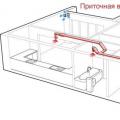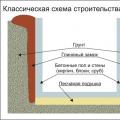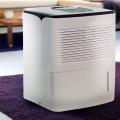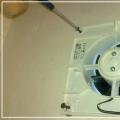Every building should be equipped with an efficient ventilation system, because constant air exchange is as important as a good heating system or quality water. Scientists have long established a connection between the development of a number of negative phenomena in homes and improper ventilation. Thus, good indoor air exchange is necessary not only to extend the life of the building, but also to maintain our health.
Why is ventilation needed?
The main purpose of ventilation is the organized supply of fresh air into the room and the subsequent replacement (or removal) of polluted air. Air exchange should be carried out with a certain frequency. Buildings with poor ventilation systems accumulate a lot of dust, microscopic chemicals (regular use of household chemicals). High humidity contributes to the formation of mold, and a high concentration of fungal spores is observed in the air.
A person working or living in such a building may complain of burning eyes, headaches, trouble concentrating, and fatigue. High humidity in buildings and poor ventilation of rooms leads to condensation and the formation of moisture droplets on ceilings and walls.
Such conditions become ideal for the development of fungi that adversely affect human health and lead to the gradual destruction of the building. Also, these factors are very often the cause of most respiratory diseases, and for people prone to allergies, they pose a serious threat to their health.
Classification of ventilation systems
Ventilation systems are classified in four main ways:
- According to the method of creating an air flow for circulation:
- artificial ventilation;
- with natural drive.
2. By appointment:
- exhaust systems;
- supply.
3. By service area:
- general exchange systems;
- local.
4. By design:
- channelless systems;
- channel.
The main types of ventilation
There are the following main types of ventilation systems:
- Natural.
- Mechanical.
- Exhaust.
- Supply.
- Supply and exhaust.
- Local.
- General exchange.
natural ventilation
As you might guess, such ventilation is created naturally, without the use of ventilation units, but only through natural air exchange, wind flows and the temperature difference between the street and the room, as well as due to fluctuations in atmospheric pressure. Such types of ventilation are relatively inexpensive in cost, and most importantly, they are easy to install. However, such systems are directly dependent on climatic conditions, therefore they are not able to cope with all problems.
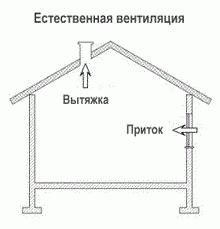
Mechanical
When the forced replacement of the exhaust air with a fresh stream is carried out, this is mechanical ventilation. In this case, special equipment is used that allows you to remove and supply air to the room in the required volume, regardless of changing climatic conditions.
In such systems, if necessary, the air is subjected to various types of treatment (humidification, dehumidification, cooling, heating, purification, and much more), which is almost impossible to organize in natural ventilation systems.
In practice, mixed types of ventilation are often used, which simultaneously combine mechanical and natural systems. For each specific case, the most optimal method of ventilation is selected in terms of sanitary and hygienic terms, and also so that it is technically and economically rational. The mechanical system can be installed both for the entire room (general exchange), and at a specific workplace (local ventilation).
Supply
Through the supply systems, a clean air flow is supplied to the ventilated premises, which replaces the polluted one. If necessary, the supply air is subjected to special treatment (humidification, heating, cleaning, etc.).
exhaust
Such a system is designed to remove polluted air from the premises. In most cases, the premises provide for both exhaust and supply types of ventilation. It is important that their performance is balanced, taking into account the possibility of air flow from adjacent rooms or into adjacent rooms.
Also, only the supply or only the exhaust system can be installed in the premises. In this case, the air enters the room from adjacent rooms or outside through special openings, or flows into adjacent rooms, or is removed from this room to the outside.
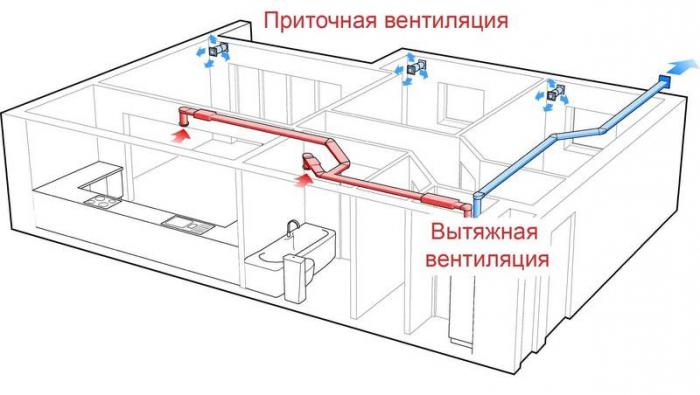
local ventilation
This is a system in which the air flow is directed to a certain place (local supply system), and polluted air is removed from the places of accumulation of harmful emissions - local exhaust (ventilation).
Local supply system
Air showers (concentrated air flow with increased speed) are local supply ventilation systems. Their main task is to supply clean air to permanent workplaces, reduce the air temperature in their area, and blow air to workers who are exposed to intense thermal radiation.
Air curtains (at stoves, gates, etc.) are also local ventilation systems, they change direction or create air barriers. Such a ventilation system, in contrast to the general exchange, requires lower costs. In industrial premises, when hazards (heat, moisture, gases, etc.) are released, a mixed ventilation scheme is usually used: local (inflow and local exhausts) - for and general - to eliminate harmful air in the entire volume of the premises.
Local exhaust system
When hazards (dust, gas, smoke) and heat are emitted locally, for example, from a stove in a kitchen or a machine in production, a local exhaust ventilation system is used. It captures and removes harmful emissions, preventing their subsequent spread throughout the entire volume of the room.
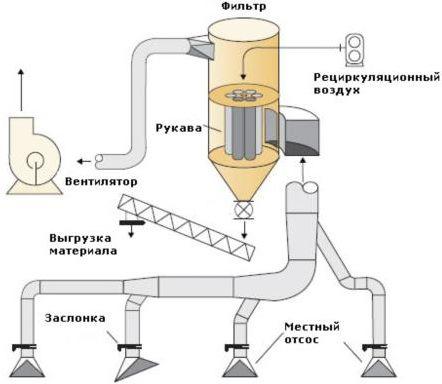
These systems include local and onboard suction, and much more. Also, local exhaust ventilation includes air curtains - air barriers that prevent air flow from the street into a room or from one room to another.
General ventilation
Such a system is designed to ventilate the room as a whole or a significant part of it. The general exchange exhaust ventilation scheme provides for the removal of air from the entire serviced premises evenly, and the general exchange supply system supplies the air flow and distributes it throughout the volume of the premises.
Natural or mechanical system: which one to choose?
For a comfortable existence, a person needs not only heat, but also clean, fresh air. Moreover, a person needs fresh air constantly and in large quantities. The volumetric velocity of the air flow in the room is also important. With a natural system, the speed is much lower than with mechanical ventilation.
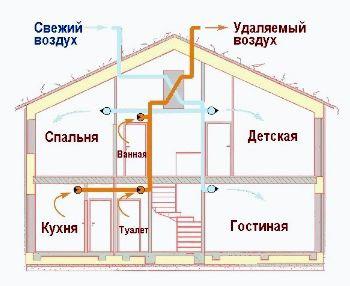
But the air exchange, which is achieved through a mechanical system, is much higher than with natural ventilation.
In addition, with a mechanical system, compared to natural ventilation, they are smaller. This is due to the normalized speed of air flow in ventilation systems. According to SNiP "Heating, ventilation and air conditioning", for a mechanical system, the air velocity should be from 3 to 5 m / s, for natural ventilation - 1 m / s. In other words, in order to pass the same volume of air through the system, natural ventilation will have duct sizes 3-5 times larger.
Very often, when building buildings, there is simply no way to skip such large channels. In addition, with a natural system, the length of the air ducts cannot be large, since the pressure created by the difference in air densities is very small. In this regard, with large areas, mechanical ventilation is simply indispensable.
Room ventilation - the main components
The composition of heating, ventilation and air conditioning includes a mass of units that provide highly efficient circulation of air masses in the room. It is important that the ventilation project, as well as the placement of devices, be carried out in accordance with the current rules and regulations (TKP, SNiP).
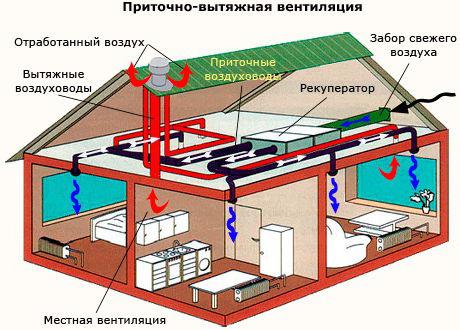
Ventilation systems can be equipped with channels or not have them - it all depends on the design features of the room.
It is important to remember that ventilation is a serious and significant element, so both the design and selection of equipment must be approached competently. It is also worth noting that universal and a wide variety of units are used to organize controlled air exchange. Fans are considered the most affordable and simple - they can be radial, axial and diametrical.
In addition, ventilation units can be installed indoors, which are mounted in special channels - air ducts, or on the roof of buildings. It also involves the installation of air valves, dampers, distribution elements and gratings, which make it possible to make the movement of air flow in the room as efficient as possible.
Main parameters of ventilation systems
- Performance. When calculating this parameter, it is necessary to take into account the number of household appliances, the number of people living in the house, as well as the area of \u200b\u200bthe premises. It should be calculated how much time and how much volume the ventilation system will need to remove polluted air and then fill it with clean air. For cottages, the most optimal value of air exchange is considered to be from 1000 to 2000 m 3 / h. To calculate the area of \u200b\u200bthe room is multiplied by its height and by 2.
- Noise level. The higher the ventilation speed, the higher the noise level. No need to purchase too "fast" systems. If the first point is calculated correctly, then you will be able not only to save your budget, but also to have a restful sleep. In this case, the installation of ventilation will be correct. Also, do not buy air ducts with low performance, as they will be difficult to install correctly, and they will not be able to withstand the load during operation. For a cottage, an acceptable average airflow velocity is from 13 to 15 m/s.
- Another important parameter is power. The temperature of the air entering the room is regulated by the heater. According to SNiP "Heating, ventilation and air conditioning", the temperature should not exceed +16°C. Depending on the intended installation location of the device, the power of the heater is calculated. It is important that it can work even at sub-zero temperatures in the winter. When choosing power, you should focus on the maximum plus and minus temperature indicators. If the maximum outside temperature is -10°C, then the heater must heat the air by at least 26°C. For example, up to 50 kW of power can be used for office space, and 1-5 kW is enough for an apartment.
scheme and installation - the main stages
Even at the design stage, it is necessary to determine the attachment points for ventilation equipment, both main and auxiliary. In this case, there are some restrictions - it is not recommended to install the equipment above heat sources (stove, fireplace, etc.). It is important that the ventilation project fully complies with the requirements that apply to regulatory and technical documentation.
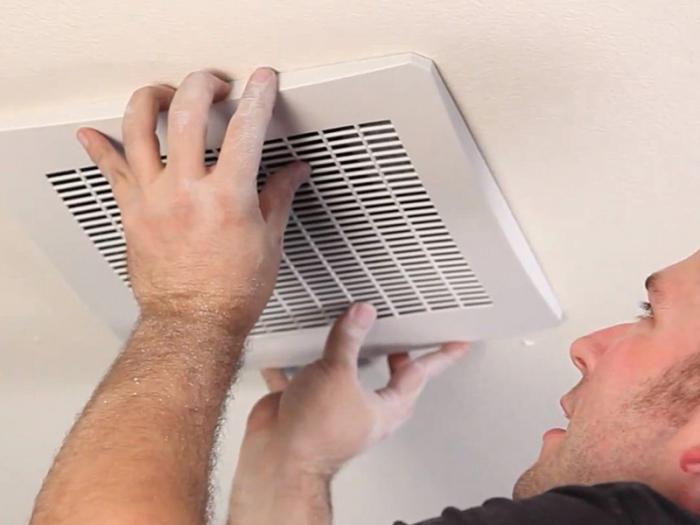
The device of the ventilation system involves the following main steps:
1. Preparation.
- The marking of the places of the proposed installation of ventilation devices is being carried out.
- Taking into account the margin (2-3 centimeters), holes are hollowed out. The stock is required for comfortable installation of the system.
- The edges of the holes are cleaned.
- The front part of the fan is installed in the pipeline section.
- Then the design is placed in the hole.
- The space between the fan and the wall is filled with foam.
3. Electrical installation.
- Grooves are made in the wall for the cable.
- The cable to the fan is laid in the resulting holes.
- The cable is fixed with brackets.
4. Finishing work.
- A protective box is installed on the fan switch.
- All joints of the ventilation system are smeared with sealant.
- Furrows with wiring, as well as the junction of the system to the wall, are plastered and puttied.
The system is completely ready to start. This is a simple ventilation, the price of such a system will depend on the cost of the fan.
Conclusion
Heating, ventilation and air conditioning systems are an integral part of a modern office, home or any other property. These systems consist of the most innovative and modern units, designed depending on the design features of the building, allowing you to save a lot on heating.
It is important to remember that a well-designed and installed ventilation system is the key to creating an optimal microclimate in the room.

